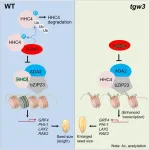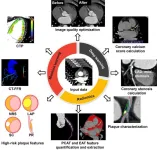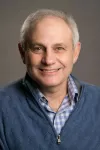(Press-News.org) A new study by Hebrew University is a significant breakthrough in understanding Tidal Disruption Events (TDEs) involving supermassive black holes. The new simulations, for the first time ever, accurately replicate the entire sequence of a TDE from stellar disruption to the peak luminosity of the resulting flare. This study has unveiled a previously unknown type of shockwave within TDEs, settling a longstanding debate about the energy source of the brightest phases in these events. It confirms that shock dissipation powers the brightest weeks of a TDE flare, opening doors for future studies to utilize TDE observations as a means to measure essential properties of black holes and potentially test Einstein's predictions in extreme gravitational environments.
[Jerusalem, Israel] – The mysteries of supermassive black holes have long captivated astronomers, offering a glimpse into the deepest corners of our universe. Now, a new study led by Dr. Elad Steinberg and Dr. Nicholas C. Stone at the Racah Institute of Physics, The Hebrew University, sheds new light on these enigmatic cosmic entities.
Supermassive black holes, ranging from millions to billions of times the mass of our Sun, have remained elusive despite their pivotal role in shaping galaxies. Their extreme gravitational pull warps spacetime, creating an environment that defies conventional understanding and presents a challenge for observational astronomers.
Enter Tidal Disruption Events (TDEs), a dramatic phenomenon that occurs when ill-fated stars venture too close to a black hole's event horizon, and are torn apart into thin streams of plasma. As this plasma returns towards the black hole, a series of shockwaves heat it up, leading to an extraordinary display of luminosity—a flare that surpasses the collective brightness of an entire galaxy for weeks or even months.
The study conducted by Steinberg and Stone represents a significant leap forward in understanding these cosmic events. For the first time, their simulations have recreated a realistic TDE, capturing the complete sequence from the initial star disruption to the peak of the ensuing luminous flare, all made possible by pioneering radiation-hydrodynamics simulation software developed by Steinberg at The Hebrew University.
This research has uncovered a previously unexplored type of shockwave within TDEs, revealing that these events dissipate their energy at a faster rate than previously understood. By clarifying this aspect, the study resolves a long-standing theoretical debate, confirming that the brightest phases of a TDE flare are powered by shock dissipation—a revelation that sets the stage for comprehensive exploration by observational astronomers.
These findings pave the way for translating TDE observations into precise measurements of crucial black hole properties, including mass and spin. Moreover, these cosmic occurrences could serve as a litmus test for validating Einstein's predictions in extreme gravitational environments.
Steinberg and Stone’s study not only unravels the intricate dynamics of TDEs but also opens a new chapter in our quest to comprehend the fundamental workings of supermassive black holes. Their simulations mark a crucial step towards harnessing these celestial events as invaluable tools for deciphering the cosmic mysteries lurking at the heart of galaxies.
Video: Disruption of solar mass star: https://www.youtube.com/watch?v=O3IWCPO_Thk
END
Origin of intense light in supermassive black holes and tidal disruption events revealed
2024-01-17
ELSE PRESS RELEASES FROM THIS DATE:
Astronomers detect oldest black hole ever observed
2024-01-17
Researchers have discovered the oldest black hole ever observed, dating from the dawn of the universe, and found that it is ‘eating’ its host galaxy to death.
The international team, led by the University of Cambridge, used the NASA/ESA/CSA James Webb Space Telescope (JWST) to detect the black hole, which dates from 400 million years after the big bang, more than 13 billion years ago. The results, which lead author Professor Roberto Maiolino says are “a giant leap forward”, are reported ...
Columbia chemists create the first 2D heavy fermion
2024-01-17
Researchers at Columbia University have successfully synthesized the first 2D heavy fermion material. They introduce the new material, a layered intermetallic crystal composed of cerium, silicon, and iodine (CeSiI), in a research article published today in Nature.
Heavy fermion compounds are a class of materials with electrons that are up to 1000x heavier than usual. In these materials, electrons get tangled up with magnetic spins that slow them down and increase their effective mass. Such interactions are ...
Therapy versus medication: comparing treatments for depression in heart disease
2024-01-17
New research by investigators from the Department of Psychiatry and Behavioral Neurosciences at Cedars-Sinai shows that behavioral activation therapy is as effective as antidepressant medications in treating symptoms of depression in patients with heart failure.
Heart failure affects nearly 6 million adults in the United States, and approximately 50% of heart failure patients experience symptoms of depression along with their condition. Past studies show patients with heart failure and depression have lower cardiac function, more emergency department ...
Active membranes: The future of fresh water is bright
2024-01-17
The growth of Los Angeles as a startup hub is highlighted by a robust and diverse entrepreneurial ecosystem within UCLA. The Magnify Incubator at CNSI is no exception to showcasing the range of early-stage businesses.
One such company within the Magnify incubator, Active Membranes, is innovating the future of fresh water through membrane desalination. As freshwater is becoming increasingly scarce around the globe, resources such as seawater and industrial wastewater are costly to procure and operate. The company’s patented technology is electrically conducting ...
What’s stopping US climate policies from working effectively
2024-01-17
In an effort to reduce greenhouse gas emissions and curb global warming, the U.S. has enacted several ambitious federal laws, such as the Inflation Reduction Act (IRA) passed in 2022 and the Infrastructure Investment and Jobs Act (IIJA) of 2021.
These provide significant investments in clean energy projects and encourage technological innovations. Some analyses suggest they could reduce greenhouse gas emissions by more than 40% below 2005 levels by 2030.
However, in a paper published Jan. 16 in the journal Nature Climate Change, researchers at the University ...
Chromatin modifier-centered pathway points to higher crop yield
2024-01-17
Chromatin is the complex of DNA and proteins that makes up the genetic material in the nucleus of eukaryotic cells. A chromatin modifier is a protein or complex of proteins that chemically modifies the structure of chromatin. Chromatin modifiers play a crucial role in regulating the expression of genes, which are segments of DNA strands, as well as in other chromatin-related processes. These modifiers mainly work by adding or subtracting chemical groups to histones, a type of protein within the chromatin, or to the DNA itself.
In the scientific effort to manipulate the expression of plant genes, such as for grain size or drought-resistance, etc., understanding the influence ...
U.S. voters’ climate change opinions swing elections
2024-01-17
When voters cast their ballots in the 2016 and 2020 presidential elections, many were driven by their concern for climate change, according to new research out of CU Boulder’s Center for Environmental Futures (C-SEF). The new report determined that views on climate change played a significant role in whom people voted for, concluding that the climate issue very likely cost Republicans the 2020 election, all else equal.
“This is obviously information that politicians and advocates across the political spectrum will want to know, heading into the 2024 election cycle,” said Matthew Burgess, CIRES Fellow and C-SEF director. “How ...
Artificial intelligence helps coronary CT angiography and accelerates the development of precision medicine
2024-01-17
This review was jointly published by Prof. Long-Jiang Zhang (Department of Radiology, Jinling Hospital, Affiliated Hospital of Medical School, Nanjing University) and Prof. Christian Tesche (Division of Cardiovascular Imaging, Department of Radiology and Radiological Science, Medical University of South Carolina and Department of Cardiology, Munich University Clinic, Ludwig-Maximilian-University).
With the continuous progress of science and technology, artificial intelligence (AI) has become an important driving force for a new round of scientific and technological revolution and industrial change. It aims to mimic human consciousness and thought processes, continuously ...
New research finds half-cardio, half-strength training reduces cardiovascular disease risks
2024-01-17
AMES, Iowa — Approximately one in three deaths in the U.S. is caused by cardiovascular disease, according to the U.S. Centers for Disease Control and Prevention. A robust body of evidence shows aerobic exercise can reduce risks, especially for people who are overweight or obese. But few studies have compared results with resistance exercise — also known as strength or weight training — or with workout regimens that are half aerobic and half resistance. Researchers at Iowa State University led one of the longest and largest supervised exercise trials to ...
ECOG-ACRIN Cancer Research Group melanoma research team led by Michael Atkins, MD, receives the 2023 Paper of the Year distinction from the Journal of Clinical Oncology
2024-01-17
A team of melanoma researchers with the ECOG-ACRIN Cancer Research Group (ECOG-ACRIN) is honored with the 2023 Paper of the Year distinction by the Journal of Clinical Oncology. The recognition is for the results of the DREAMseq randomized phase 3 clinical trial. DREAMseq (EA6134) showed an optimal treatment sequence for combination therapy in patients with advanced melanoma with a BRAFV600 tumor gene mutation. The treatment sequence beginning with immunotherapy (nivolumab and ipilimumab), followed by targeted therapy (dabrafenib and trametinib) if there was disease progression, resulted ...





